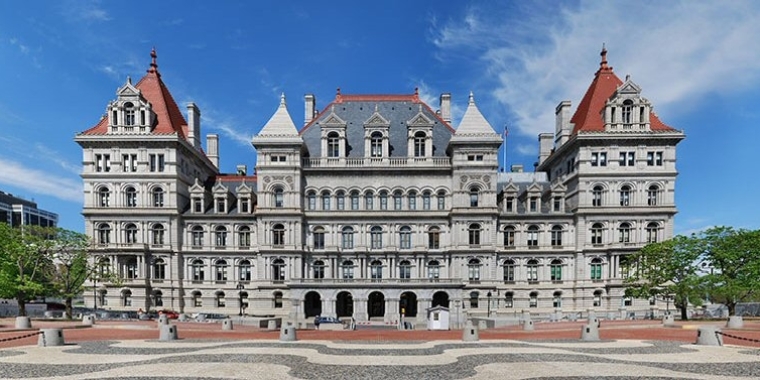
DEP Completes Building for Odor Control At Owls Head Wastewater Treatment Plant
Martin J. Golden
July 5, 2011
-
ISSUE:
- Environment
Separate Energy Projects Will Cut Plant’s Carbon Footprint and Electricity Demand
Environmental Protection Commissioner Cas Holloway today announced the completion of a state-of-the-art Residuals Handling Building at the Owls Head Wastewater Treatment Plant and two projects that will cut carbon emissions at the plant by 19,000 metric tons a year and reduce the electricity needed to run the plant. The three-story building will provide a centralized location for the handling and disposal of the materials removed from the approximately 100 million gallons of wastewater that the plant treats every day, including trash, sand, stones, grease, grit, and other materials that are captured in the early stages of the treatment process. The Central Residuals Building includes a state-of-the-art odor control system to help ensure odors are not released into the surrounding community. A new fire alarm system is still being installed and expected to be completed in the coming weeks. The overall cost of the building is approximately $49 million.
“The completion of the Residuals Handling Building at Owls Head will go a long way toward minimizing odors at the plant and resolving longstanding community concerns that Mayor Bloomberg committed to address in 2006,” said Commissioner Holloway. “We have come a long way since then, from the carbon filters we installed last year, to the completion of this nearly $50 million facility, which should improve the quality of life for everyone who lives in and visits this vibrant community. The investments we’ve made here will also make the plant operate more efficiently and reduce greenhouse gases—all part of our effort to reduce GHG emissions from City facilities by 30% by 2017.”
“The Department of Environmental Protection continues to address the odor conditions emanating from the Owls Head plant,” said State Senator Marty Golden. “Today, they maintain that commitment and on behalf of the quality of life of the community, I thank Commissioner Holloway and the Department for these efforts.”
“The completion of this building is the latest in my and DEP’s commitment to bringing an end to the Owls Head odors that have plagued residents for far too long,” Councilman Vincent Gentile said. “Thank you to Commissioner Holloway for taking the problem seriously and for pushing solutions through for the good of our community.”
The residuals building is approximately 200 feet long by 85 feet wide and 60 feet high. It houses five containers to collect residuals from the plant as well as mechanical, electrical and odor control equipment, conveyors and compactors. The wastewater that enters the treatment plant passes through screens, which remove trash, including rags, sticks, and bottles. These objects, along with the sand, stones, grease, and grit that are removed from the wastewater early in the treatment process are collectively called residuals. Removing residuals protects the main sewage pumps and other equipment at the wastewater treatment plant and keeps them out of waterways. The residuals matter is then trucked to a landfill.
In separate work that will help reduce DEP’s carbon footprint and reduce electricity demand, a more efficient air diffuser system was installed, which better controls the delivery of air throughout the wastewater treatment process, resulting in a reduction of electrical power required to operate the large air compressors. Another project, expected to be completed in 2013, will increase the use of digester gas to fuel the plant’s generators and boilers, which will reduce the need for diesel fuel. Digester gas is a byproduct of the wastewater treatment process. The project will cost approximately $20 million.
Last May, Commissioner Holloway announced the installation of two activated carbon filters, which have reduced hydrogen sulfide — the primary odor compound in sewage and the most dominant odor emitted from wastewater treatment plants — by 90% from 2006 levels, before odor control upgrades were initiated. With the carbon filters coming online and the completion of the Residuals Handling Building, DEP expects that odors will be substantially reduced as a community concern.
Since 2006, DEP has taken significant steps to mitigate odors at Owls Head, including:
· Installing temporary covers on top of open primary tank launders and installing nine, 55-gallon drums of carbon, which helped reduce odors until a more comprehensive fix could be implemented.
· Enclosing storage of waste containers. Waste containers store odorous grease and grit from the wastewater treatment process and enclosing the containers reduced odors that previously escaped into the air.
· Rehabilitating venting systems on the screening building at a cost of $100,000.
· Installing a new digesting flare at a cost of $200,000. The new flare helps to better break down odorous compounds.
· Installing sealed aluminum covers, which cost $800,000 to replace the temporary covers. Aluminum covers are more durable and hold up to humid and corrosive conditions of wastewater treatment.
The Owls Head Wastewater Treatment Plant went into operation in 1952 and is designed to treat 100 million gallons of wastewater a day. New Yorkers produce, and DEP treats, more than 1.3 billion gallons of wastewater every day. The wastewater is collected through 7,400 miles of lateral sewers that flow downhill into large interceptor sewers, which lead directly to the City’s 14 wastewater treatment plants.
DEP manages the city’s water supply, providing more than 1 billion gallons of water each day to more than 9 million residents, including 8 million in New York City. New York City’s water is delivered from a watershed that extends more than 125 miles from the city, and comprises 19 reservoirs, and three controlled lakes. Approximately 7,000 miles of water mains, tunnels and aqueducts bring water to homes and businesses throughout the five boroughs, and 7,400 miles of sewer lines take wastewater to 14 in-city treatment plants. For more information, visit www.nyc.gov/dep or follow us on Facebook at www.facebook.com/nycwater.
Share this Article or Press Release
Newsroom
Go to Newsroom2018 Civil Service & Pensions Committee Annual Report
December 27, 2018

Golden to Mayor: Time for police negotiations long overdue.
August 6, 2018

Concepcion "Connie" Ranocchia
May 15, 2018

